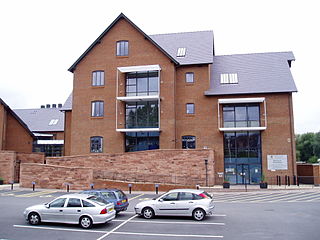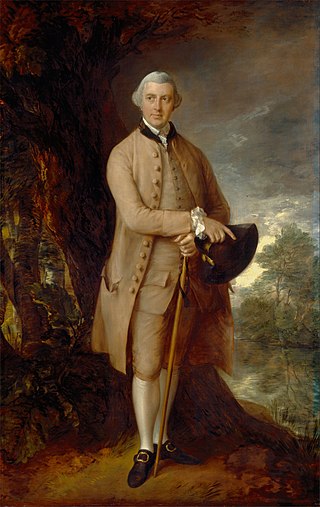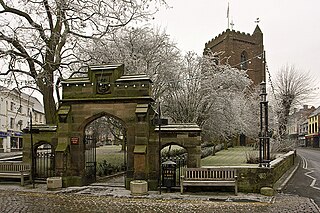
Shropshire is a ceremonial county in the West Midlands of England, on the border with Wales. It is bordered by Cheshire to the north, the Welsh county of Wrexham to the north and northwest, Staffordshire to the east, Worcestershire to the southeast, Herefordshire to the south, and the Welsh county of Powys to the west. The largest settlement is Telford, while Shrewsbury is the county town.

Newport is a market town in the borough of Telford and Wrekin in Shropshire, England. It lies 7 miles (11 km) north-east of Telford town centre, 12 miles (19 km) west of Stafford, and is near the Shropshire-Staffordshire border. The 2001 census recorded 10,814 people living in the town's parish, which rose to 11,387 by the 2011 census.

William Pulteney, 1st Earl of Bath, was an English Whig politician and peer who sat in the British House of Commons from 1707 to 1742 when he was raised to the peerage as the Earl of Bath by George II of Great Britain. He is sometimes represented as having served as First Lord of the Treasury and Prime Minister of Great Britain as part of the short-lived ministry in 1746, although most modern sources do not consider him to have held the office.

Shrewsbury and Atcham was a local government district with borough status in Shropshire, England, between 1974 and 2009.

Shrewsbury Castle is a red sandstone castle in Shrewsbury, Shropshire, England. It stands on a hill in the neck of the meander of the River Severn on which the town originally developed. The castle, directly above Shrewsbury railway station, is a Grade I listed building.

Much Wenlock is a market town and parish in Shropshire, England; it is situated on the A458 road between Shrewsbury and Bridgnorth. Nearby, to the north-east, is the Ironbridge Gorge and Telford. The civil parish includes the villages of Homer, Wyke, Atterley, Stretton Westwood and Bourton. The population of the civil parish, according to the 2001 Census, was 2,605, increasing to 2,877 by 2011.

Albrighton is a large village and civil parish in Shropshire, England, 8 miles (13 km) northwest of Wolverhampton and 11 miles (18 km) northeast of Bridgnorth.

Frankwell is a district of the town of Shrewsbury, in Shropshire, England. It lies adjacent to the River Severn, to the northwest of the town centre, and is one of Shrewsbury's oldest suburbs. The main road running through the area is also called Frankwell.
This is a list of people who have served as Lord Lieutenant of Shropshire. Before the English Civil War, the lieutenancy of Shropshire was always held by the Lord Lieutenant of Wales, but after the Restoration, its lieutenants were appointed separately. Since 1708, all the Lord Lieutenants have also been Custos Rotulorum of Shropshire.

St George's Bridge was a bridge over the River Severn in Shrewsbury, England; so named as it was close to the medieval St George's Hospital. It connected Frankwell, an old suburb of the town, to the town centre via Mardol. The gate on the town side was called Mardol Gate and is located where the Mardol Quay Gardens are. The gate on the other side was called Welsh Gate or St George's Gate. The bridge, sometimes now known as the Old Welsh Bridge, was demolished in 1795 and was replaced with the Welsh Bridge.
The town of Shrewsbury in Shropshire, England, has a history that extends back at least as far as the year 901, but it could have been first settled earlier. During the early Middle Ages, the town was a centre of the wool trade, and this was a peak in its importance. During the Industrial Revolution, comparatively little development took place in the town, although it did serve as a significant railway town after the development of rail transport in the area. The town today retains much of its historic architecture.

Sir William Pulteney, 5th Baronet was a Scottish lawyer, Whig politician and landowner who sat in the British House of Commons between 1768 and 1805. One of the wealthiest Britons during his lifetime, he invested in the construction of several prominent buildings in Britain, including the Pulteney Bridge and other properties in Bath, Somerset, several beachfront residences in Weymouth, Dorset and roads in Scotland. Pulteney was also a patron of architect Robert Adam and civil engineer Thomas Telford. He also owned slave plantations in British America.

Newport Guildhall is a large timber-framed municipal building in Newport, Shropshire, England. It is a Grade II* listed building.

St Nicholas's Church is an Anglican church in the market town of Newport, Shropshire, England lying within the Diocese of Lichfield. It is dedicated to St Nicholas, the patron saint of fishermen. The church is a Grade II* listed building.

Shrewsbury is a market town, civil parish and the county town of Shropshire, England. It is sited on the River Severn, 33 miles (53 km) northwest of Wolverhampton, 15 miles (24 km) west of Telford, 31 miles (50 km) southeast of Wrexham and 53 miles (85 km) north of Hereford. At the 2021 census, the parish had a population of 76,782.

Shrewsbury Museum and Art Gallery was founded in 1835 as the Museum of the Shropshire and North Wales Natural History and Antiquarian Society Society in Dogpole, Shrewsbury, England. In 1853 the collections were moved to Vaughan's Mansion on College Hill, which became known as the Shropshire and North Wales Museum. After 160 years and two subsequent homes the museum returned to Vaughan's Mansion and the Music Hall Complex after a major redevelopment of the site.

Edward Haycock Sr. was an English architect renowned for his work in the West Midlands and central and southern Wales during the late Georgian and early Victorian periods.

University Centre Shrewsbury was a Higher Education Institution in Shrewsbury, Shropshire. As of September 2024 it is permanently closed.

The Old Shirehall was a municipal facility in Market Square, Shrewsbury, Shropshire. It was demolished in 1971 to make way for a retail and commercial centre.
The town of Shrewsbury in Shropshire, England has historically been affected by flooding of the River Severn. The Frankwell area, has been particularly affected, but flood defence measures have largely been effective in the area.


















